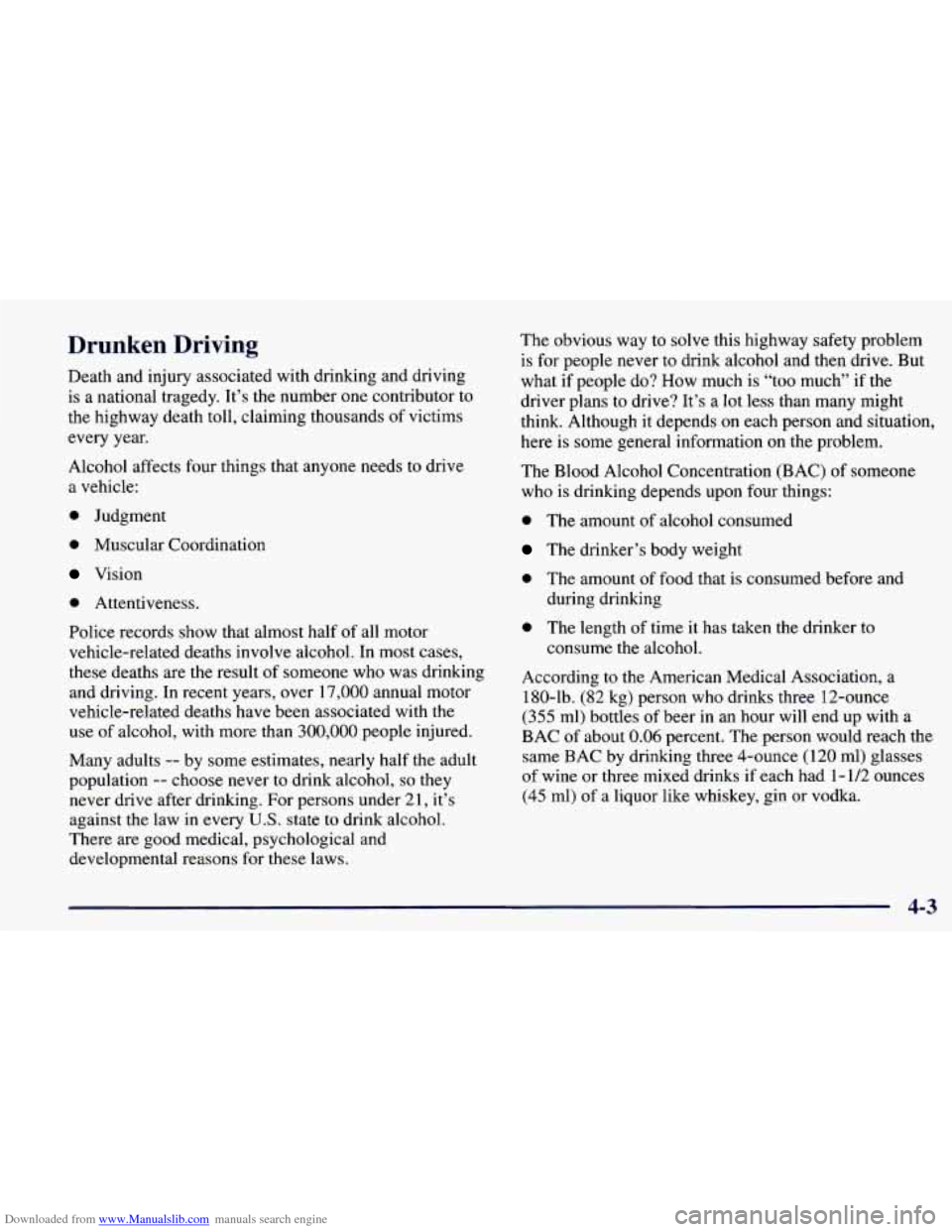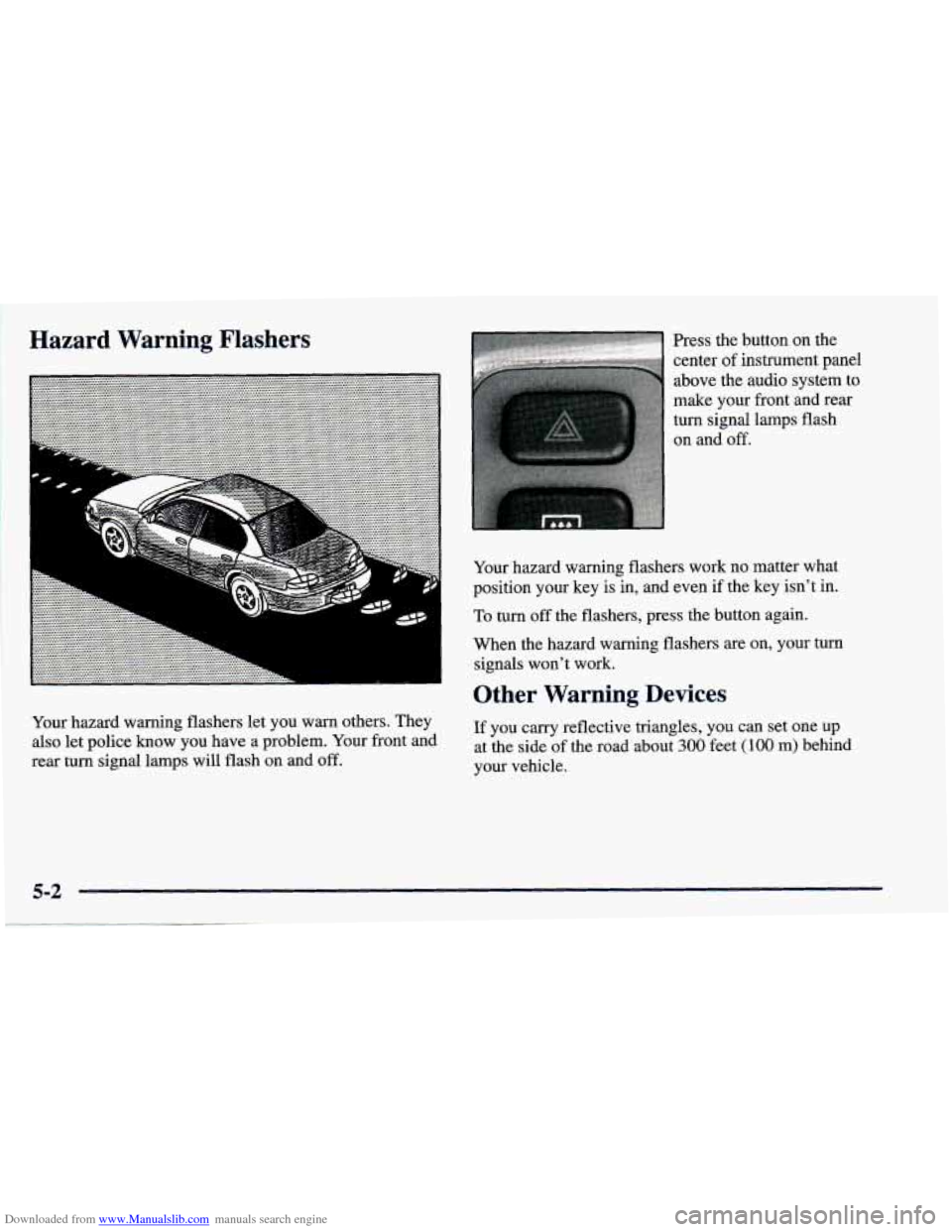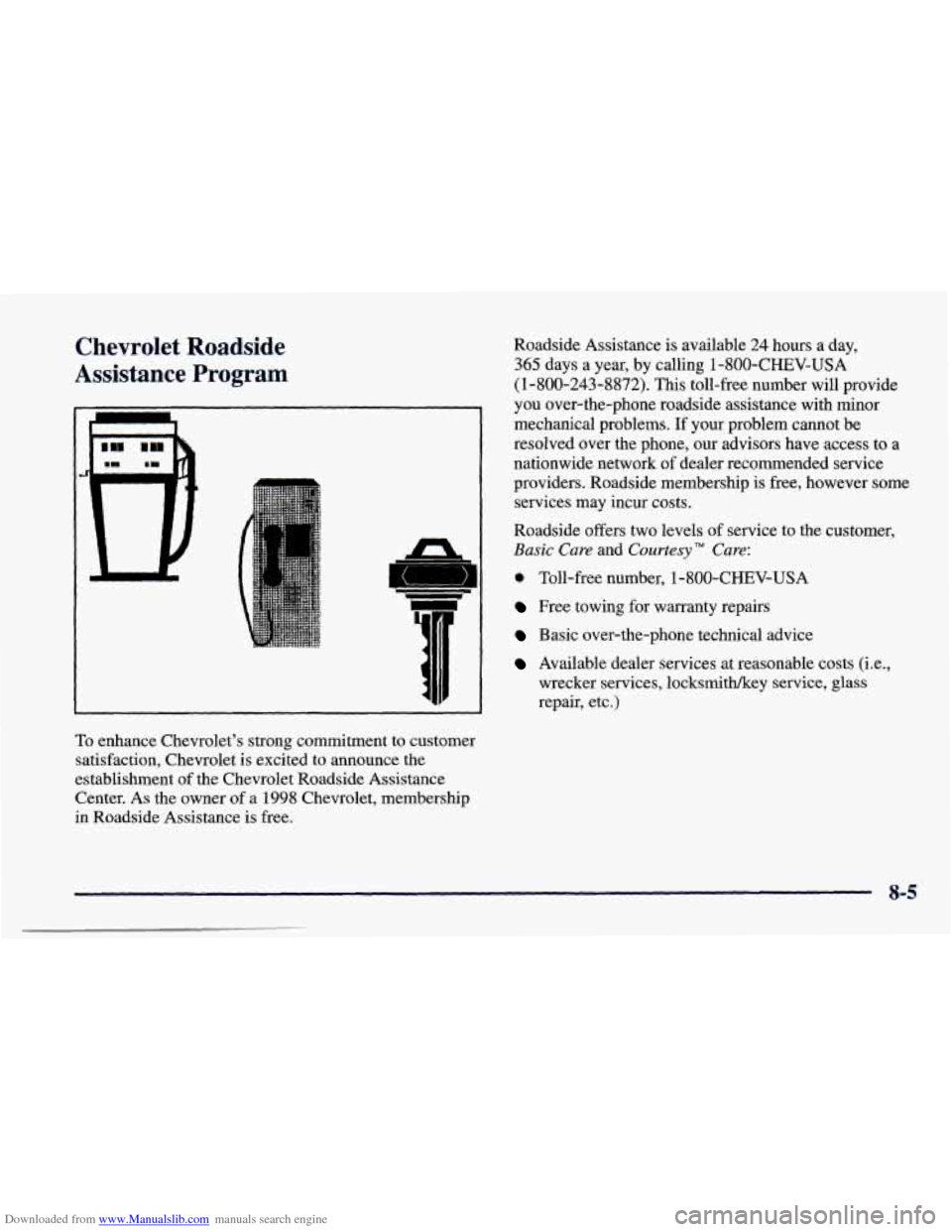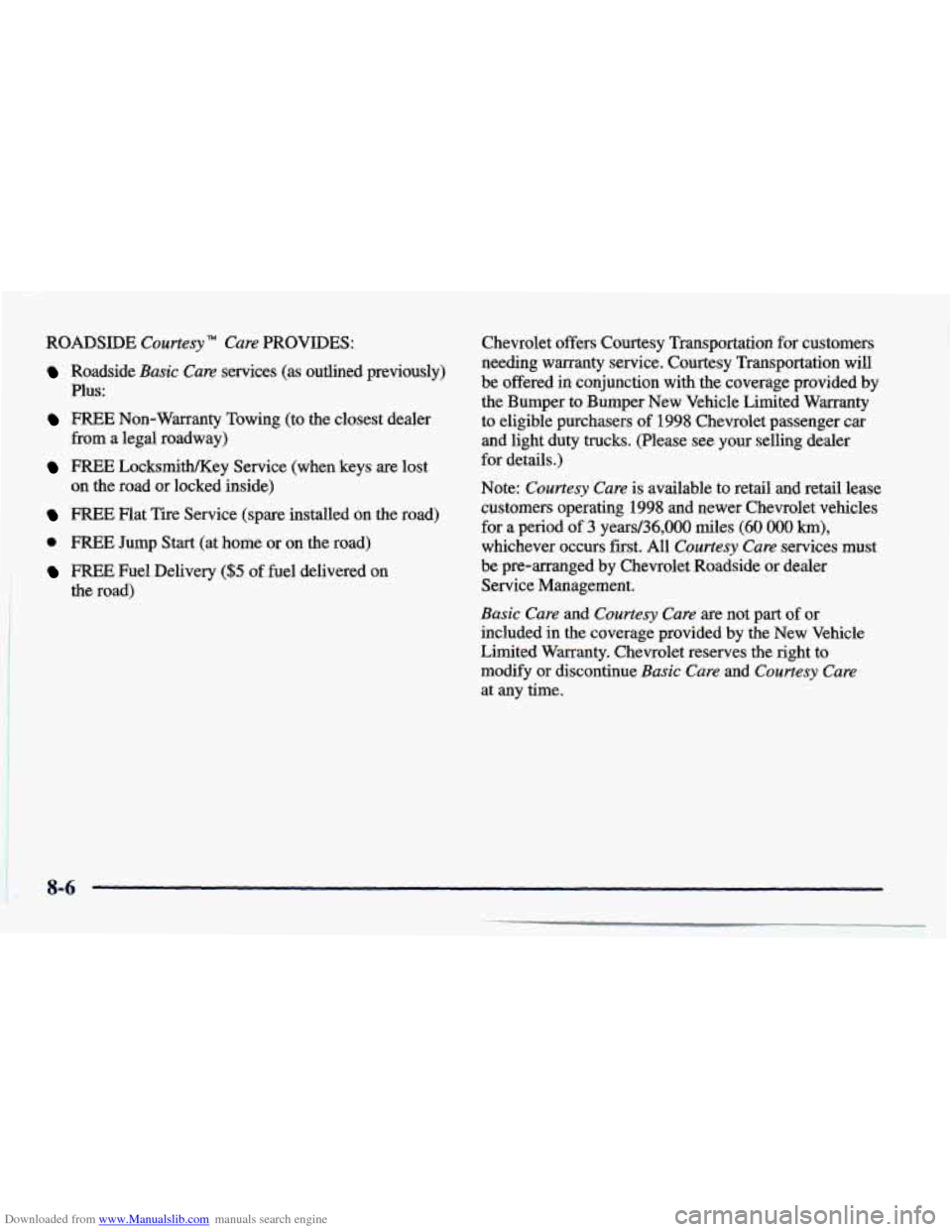1998 CHEVROLET PRIZM key
[x] Cancel search: keyPage 155 of 364

Downloaded from www.Manualslib.com manuals search engine Drunken Driving
Death and injury associated with drinking and driving
is a national tragedy. It’s the number one contributor to
the highway death toll, claiming thousands of victims
every year.
Alcohol affects four things that anyone needs to drive
a vehicle:
0 Judgment
0 Muscular Coordination
Vision
0 Attentiveness.
Police records show that almost half of all motor
vehicle-related deaths involve alcohol. In most cases,
these deaths are the result of someone who was drinking
and driving. In recent years, over
17,000 annual motor
vehicle-related deaths have been associated with the
use of alcohol, with more than
300,000 people injured.
Many adults
-- by some estimates, nearly half the adult
population
-- choose never to drink alcohol, so they
never drive after drinking. For persons under 21, it’s
against the law in every
US. state to drink alcohol.
There are good medical, psychological and
developmental reasons for these laws. The
obvious way
to solve this highway safety problem
is
for people never to drink alcohol and then drive. But
what if people do? How much is “too much”
if the
driver plans to drive? It’s a lot less than many might
think. Although it depends on each person and situation,
here is some general information
on the problem.
The Blood Alcohol Concentration (BAC)
of someone
who is drinking depends upon four things:
0 The amount of alcohol consumed
The drinker’s body weight
0 The amount of food that is consumed before and
during drinking
consume the alcohol.
0 The length of time it has taken the drinker to
According to the American Medical Association,
a
180-lb. (82 kg) person who drinks three 12-ounce
(355 ml) bottles of beer in an hour will end up with a
BAC of about
0.06 percent. The person would reach the
same BAC by drinking three 4-ounce (120 ml) glasses
of wine or three mixed drinks if each had
1- 1/2 ounces
(45 ml) of a liquor like F skey, gin or vodka.
4-3
Page 192 of 364

Downloaded from www.Manualslib.com manuals search engine Hazard Warning Flashers
Your hazard warning flashers let you warn others. They
also let police know you have a problem. Your front and
rear
turn signal lamps will flash on and off.
Press the button on the
center of instrument panel
above the audio system
to
make your front and rear
turn signal lamps flash
Your hazard warning flashers work no matter what
position your key is in, and even if the key isn't in.
To turn off the flashers, press the button again.
When the hazard warning flashers are on, your
turn
signals won't work.
Other Warning Devices
If you carry reflective triangles, you can set one up
at the side of the road about 300 feet (100 m) behind
your vehicle.
5-2
Page 199 of 364

Downloaded from www.Manualslib.com manuals search engine A vehicle can fall from a car carrier if it isn’t
adequately secured, This can cause a collision,
serious personal injury and vehicle damage. The
vehicle should be tightly secured with chains
or
steel cables before it is transported.
Don’t use substitutes (ropes, leather straps,
canvas webbing, etc.) that can be cut by sharp
edges underneath the towed vehicle. Always use
T-hooks inserted in the T-hook slots, Never use
J-hooks. They
will damage drivetrain and
suspension components.
When your vehicle is being towed, have the ignition
key turned to
OFF. The steering wheel should
be clamped in a straight-ahead position, with a
clamping device designed for towing service. Do not
use the vehicle’s steering column lock for this. The
transaxle should be in
NEUTRAL (N) and the
parking brake released.
Don’t have your vehicle towed with the front wheels in
contact with the ground if it has
an automatic transaxle.
If
a vehicle with an automatic transaxle must be towed
from the rear with wheel-lift equipment, the front
wheels must be supported on a dolly.
If your vehicle has a manual transaxle, don’t have it
towed on the front wheels unless you must. If a vehicle
with a manual transaxle must be towed on the front
wheels, it is recommended that the front wheels be
supported on a dolly. If you have a manual transaxle
and dollies won’t be used, turn the ignition key to
ACC
and put the transaxle in NEUTRAL (N).
5-9
Page 325 of 364

Downloaded from www.Manualslib.com manuals search engine At Least Once a Year
Key Lock Cylinders Service
Lubricate the key lock cylinders with the lubricant
specified in Part
D.
Seat 01 ion Check
Make sure the head restraints stay in position and all
seat latches lock. Check that the recliner holds by
pushing and pulling the seatback while it
is reclined.
Body Lubrication Service
Lubricate all body door hinges. Also lubricate all
hinges and latches, including those for the hood, secondary latches, rear compartment and any folding
seat hardware. Part
D tells you what to use. More
frequent lubrication may be required when exposed to
a corrosive environment.
Starter Switch Check
When you are doing this check, tne vehicle could
move suddenly.
If it does, you or others could be
injured. Follow the steps below.
1. Before you start, be sure you have enough room
around the vehicle.
2. Firmly apply both the parking brake (see “Parking
Brake” in the Index if necessary) and the regular brake.
NOTE: Do not use the accelerator pedal, and be
ready to turn off the engine immediately if it starts.
3. On automatic transaxle vehicles, try to start the
engine
in each gear. The starter should work only in
PARK (P) or NEUTRAL (N). If the starter works in
any other position, your vehicle needs service.
On manual transaxle vehicles, put the shift lever in
NEUTRAL (N), push the clutch down halfway and
try to start the engine. The starter should work only
when the clutch is pushed down all the way
to the
floor. If the starter works when the clutch isn’t
pushed all the way down, your vehicle
needs service.
7-39
Page 326 of 364

Downloaded from www.Manualslib.com manuals search engine Brake-Transaxle Shift Interlock (BTSI) Check (Automatic Transaxle) Ignition Transaxle Lock Check
While parked, and
with the parking brake set, try to turn
the ignition key to
LOCK in each shift lever position.
r
With an automatic transaxle, the key should turn to
LOCK only when the shift lever is in PARK (P).
LOCK only if you push the key in farther, while
turning it towards
LOCK.
When you are doing this check, the vehicle could With a manual transaxle, the key should turn to
move suddenly. If it does, you or others could be
injured. Follow the steps below.
1. Before you start, be sure you have enough room
around the vehicle. It should be parked
on a
level surface.
2. Firmly apply the parking brake (see “Parking Brake”
in the Index if necessary).
NOTE: Be ready
to apply the regular brake
immediately if the vehicle begins
to move.
3. With the engine off, turn the key to the ON position,
but don’t start the engine. Without applying the
regular brake,
try to move the shift lever out of
PARK (P) with normal effort. If the shift lever
moves out
of PARK (P), your vehicle’s BTSI
needs service.
7-40
Page 330 of 364

Downloaded from www.Manualslib.com manuals search engine Part D: Recommended Fluids
and Lubricants
NOTE: Fluids and lubricants identified below by name,
part number or specification may be obtained from
your dealer.
USAGE ~- ~-
Engine Oil
Engine Coolant
FLUID/LUBRICANT
Engine Oil with the American
Petroleum Institute Certified For
Gasoline Engines “Starburst”
symbol
of the proper viscosity.
To determine the preferred
viscosity for your vehicle’s
engine, see “Engine Oil” in the
Index.
50/50 mixture of clean water
(preferably distilled) and good
quality Ethylene Glycol Base
Coolant (GM Part No. 1052753
or equivalent) conforming to GM
Specification 1825M or approved
recycled coolant conforming to
GM Specification 1825M. See
“Engine Coolant”
in the Index.
USAGE
Hydraulic Brake
System
Hydraulic Clutch System
Power Steering System
~~ ~ ~
Manual Transaxle
Automatic
Transaxle Key Lock
Cylinders
FLUID/LUBRICANT
Delco Supreme 11 @ Brake Fluid
(GM Part
No. 12377967 or
equivalent DOT-3 Brake Fluid).
Hydraulic Clutch Fluid (GM Part
No. 12345347 or equivalent
DOT-3 Brake Fluid).
DEXRON@-I11 Automatic
Transmission Fluid. GM Goodwrench Synthetic
Manual Transmission Gear Oil
(GM Part No. 12346190
- 1
quart) or equivalent SAE 75W-90
GL-4 Gear Oil.
DEXRON@-111 Automatic
Transmission Fluid.
Multi-Pu ose Lubricant,
Superlube
% (GM Part
No. 1234624 1 or equivalent).
7-44
Page 339 of 364

Downloaded from www.Manualslib.com manuals search engine Chevrolet Roadside
Assistance Program Roadside Assistance is available 24 hours a day,
365 days a year, by calling 1-800-CHEV-USA
(1 -800-243-8872). This toll-free number will provide
you over-the-phone roadside assistance with minor
mechanical problems.
If your problem cannot be
resolved over the phone, our advisors have access to
a
nationwide network of dealer recommended service
providers. Roadside membership
is free, however some
services may incur costs.
Roadside offers two levels of service to the customer,
Basic Care and Courtesy" Care:
0 Toll-free number, 1 -800-CHEV-USA
Free towing for warranty repairs
Basic over-the-phone technical advice
Available dealer services at reasonable costs (i.e.,
wrecker services, locksmithkey service,
glass
repair, etc.)
To enhance Chevrolet's strong commitment to customer
satisfaction, Chevrolet is excited to announce the
establishment of the Chevrolet Roadside Assistance
Center. As the owner of a
1998 Chevrolet, membership
in Roadside Assistance is free.
8-5
Page 340 of 364

Downloaded from www.Manualslib.com manuals search engine ROADSIDE Courtesy" Care PROVIDES:
Roadside Basic Care services (as outlined previously)
FREE Non-Warranty Towing (to the closest dealer
FREE Locksmith/Key Service (when keys are lost
Plus:
from a legal roadway)
on
the road or locked inside)
FREE Flat Tire Service (spare installed on the road)
0 FREE Jump Start (at home or on the road)
FREE Fuel Delivery ($5 of fuel delivered on
the road) Chevrolet offers Courtesy Transportation
for customers
needing warranty service. Courtesy Transportation will
be offered in conjunction with the coverage provided by
the Bumper to Bumper New Vehicle Limited Warranty
to eligible purchasers of 1998 Chevrolet passenger car
and light duty trucks. (Please see your selling dealer
for details.)
Note:
Courtesy Care is available to retail and retail lease
customers operating
1998 and newer Chevrolet vehicles
for a period
of 3 years/36,000 miles (60 000 km),
whichever occurs first. All Courtesy Care services must
be pre-arranged by Chevrolet Roadside or dealer
Service Management.
Basic Care and Courtesy Care are not part of or
included in the coverage provided
by the New Vehicle
Limited Warranty. Chevrolet reserves the right to
modify or discontinue
Basic Care and Courtesy Cure
at any time.